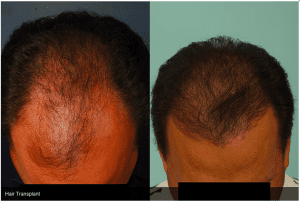October 30, 2015 | Hair Transplant, Hair Treatment, Plastic Surgery News
 Hair plays a significant role in defining our self-image, self-esteem, and overall appearance. Socially and culturally, it is strongly associated with well-being and youth, which explains why currently many men and women suffering from hair loss seek hair restoration. Hair also serves an important function – that of protecting the scalp. Dr. Agullo embraces science and expertise and translates it into restored beauty through hair transplant procedures.
Hair plays a significant role in defining our self-image, self-esteem, and overall appearance. Socially and culturally, it is strongly associated with well-being and youth, which explains why currently many men and women suffering from hair loss seek hair restoration. Hair also serves an important function – that of protecting the scalp. Dr. Agullo embraces science and expertise and translates it into restored beauty through hair transplant procedures.
There are roughly five million hair follicles on the human body; approximately 100,000 are located on the scalp. The number of follicles varies depending on hair color, with the highest follicle count in blonde, lower in brunettes, and lowest in red hair.
The Hair Growth Cycle
Hair normally grows at a speed of 0.25 to 0.5 inch per month and undergoes a growth pattern, which has the following three phases: anagen, telogen, and catagen.
Growth Phase: “Anagen”
- Known as the active growth phase
- Can last between three to ten years
Degeneration Phase: “Catagen”
- Hair stops growing and sheds and then transitions into the next phase
- Lasts anywhere between two to three weeks
Resting Phase: “Telogen”
- A new hair follicle begins to form and gets ready to enter growth phase again
- Usually lasts three to four months
On average, we shed between 25 to 100 hairs daily. Approximately between 4 to 24 percent of the hair follicles on the scalp are in the resting phase. This is normal and not indicative of any hair loss condition. Most of the hair is in the active growth phase and a very small percentage in the shedding phase.
The Role of Hormones and Genes in Hair Loss
Alopecia is the medical term for loss. The most common form of hair loss is known as androgenetic alopecia, where both hormones and genes play a role. Hence, the technical term for male and female pattern hair loss is androgenetic alopecia (AGA) i.e. with androgens (andro) as well as genes (genetic). It is often progressive and occurs in both men and women; however, it is much more common in men. AGA is also known as male pattern baldness and affects approximately 50 percent of men by age 50.
The androgen hormone known as testosterone and its metabolite dihydrotestosterone (DHT) play an important role in AGA. This condition causes hair follicles to grow thin and short, known as “miniaturized hair,” and has a vellus appearance. While the growth of facial, underarm, and pubic hair is determined by testosterone, scalp hair is not. Both male and female pattern hair loss are linked to an inherited sensitivity to the effects of DHT on the hair follicles of the scalp. In addition to hormones, hair loss genes play an important role in hair loss as well. AGA is a condition that runs in families so to speak. The family history of baldness can be helpful in predicting the pattern and severity of hair loss.
While AGA runs in the family, it is not definite that a person will carry it just because his/her father or aunt has it. AGA simply makes it much more likely that the next generation will carry the condition.
Most patients who come to Dr. Agullo for hair restoration have AGA. However, it is of utmost importance to eliminate any other conditions that cause hair loss. Dr. Agullo will carefully and thoroughly evaluate you to determine whether hair restoration is right for you. With his experience and in-depth understanding of hair loss, Dr. Agullo routinely provides invaluable advice to patients regarding the nature of hair loss and the treatments that exist, both medical and surgical.
If you are concerned with hair loss, schedule a consultation with double board-certified plastic surgeon Dr. Frank Agullo. Call our El Paso office at (915) 590-7900 or our Las Cruces office at (575) 520-5041 to schedule your personal consultation. For your convenience, you may also contact us online at our El Paso Office.



